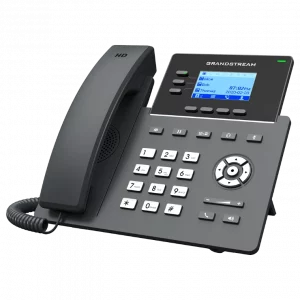
What is SIP Calling, and How Does It Make Communications Easier?
Business owners often identify modernization or upgrading technology platforms as synonymous with significant financial investment. While that may have been the case in the past, advances in cloud technology have changed the paradigm. A perfect example of how small and mid-sized enterprises (SMEs) can level up their communications technology is by implementing Session Initiation Protocol (SIP). But what is SIP?
Think of SIP as a virtual phone line. It works with Voice over Internet Protocol (VoIP) to initiate and transmit calls via the Internet. It is a cost-effective solution to transition traditional hardware-dependent phone systems to a virtual one. This versatile technology is steadily increasing in popularity as evidenced by the market value that is projected to reach $40.77 billion by 2030.
We’ll explain how it can make communications easier and decrease your phone network expenses while providing several key benefits to your business.
What Is SIP Calling?
In legacy Private Branch Exchange (PBX) systems, Primary Rate Interface (PRI) or physical copper telephone lines connected calls to the Public Switched Telephone Network (PSTN). The PSTN is responsible for routing each call to its destination. It was time-consuming and expensive to order lines, install them, and wait for a technician to establish the service at brick-and-mortar locations. It also meant that the company was literally tethered to a physical locale.
However, with SIP, there’s no longer a need for a physical connection to a phone company with multiple phone lines. Instead, SIP calling uses the SIP protocol with VoIP to virtually transmit voice, video, and data traffic. A SIP trunk is merely a collection of virtual phone lines, also known as channels. When the SIP trunk is enabled over the current internet connection, it allows traffic to bypass PRI lines and connect directly to the PSTN via the internet.
While VoIP can function without SIP, SIP is a versatile protocol that provides compatibility with a broader range of online calling, productivity, and messaging software, making it an ideal choice for businesses needing the flexibility to integrate with third-party applications.
How Does SIP Make Communications Easier?
What SIP calling does for business communications is provide improvements and conveniences that are unavailable with legacy systems. It leverages the latest technology to put even small businesses in a more competitive position. SIP calling improves communications by making it easy for clients to reach you and allowing you to interact with your customers where and how they prefer. And it does all this with significant cost savings over traditional communication methods.
Let’s look at some of the many advantages of utilizing SIP phone systems.
Recurring Cost Savings
The costs associated with PRI systems are often higher than those associated with SIP trunking. The higher costs are due to the maintenance and upkeep of the bundle of copper wires that PRI requires. As PRI technology becomes obsolete, the prices for maintaining these connections will continue to rise.
On the other hand, SIP uses the internet to carry the signal virtually rather than relying on physical wiring connectivity. Businesses realize cost savings with SIP in the following ways:
- There are no substantial upfront investments necessary for hardware and installation. Maintenance costs are eliminated since SIP uses the internet instead of expensive phone lines.
- Subscription fees are removed with the elimination of a PSTN gateway. It’s no longer necessary to subscribe to different services for voice and data separately since they are consolidated into one network.
- There are no extra charges for long-distance calls. They are all turned into local calls. Instead of being charged by the minute, users have the option to pay a monthly fixed fee based on the number of channels provisioned for unlimited calls.
- SIP uses one centralized network rather than multiple networks.
Improved Flexibility and Scalability
SIP facilitates enhanced flexibility and scalability for businesses. With traditional phone systems, companies often face challenges when it comes to scaling their operations or adapting to changing business needs. However, SIP calling operates on a virtual infrastructure that can easily accommodate fluctuations in call volume and organizational growth. Whether a company is expanding its customer base or launching new products and services, SIP calling provides the flexibility to scale communication resources accordingly, ensuring that customer inquiries are always addressed promptly and efficiently.
Related: How Many Sip Trunks Does a Small Business Need?
With SIP, the network can identify user locations, reroute calls, be used for video conferencing, allow 911 emergency calls, forward calls with recording features, and route calls to different locations or operating centers. In addition, it allows companies to add or remove features as their needs change, often from a convenient dashboard.
SIP networks are easily scaled by purchasing and assigning additional channels as needed. As your company grows, bandwidth and users can be added or modified from a single platform. The ease of scalability in SIP takes the guesswork out of planning for future growth and eliminates the need to house extra equipment for future lines.
Easier Implementation
SIP calling is easy to implement in the office. Maintenance is done through a user-friendly online control panel. With the consolidation of communication needs into one platform, staff only need training on one system, simplifying the process and ensuring everyone is on the same page. With the right provider, it’s possible to be up and running in a matter of minutes, not days or weeks.
Reduced Maintenance
Without a physical infrastructure, there are no lines or equipment to maintain. Adding, monitoring, and troubleshooting channels is efficiently done online through a control panel. Services are quickly rerouted in the event of a failure, minimizing downtime and ensuring business continuity. Software updates are easily done remotely, preventing downtime and onsite service calls that would otherwise interfere with day-to-day operations.
Improved Sound Quality
Today’s SIP services provide high-definition calls, extended frequency, and twice the sample rate of traditional telephone audio. This translates to a dramatic improvement in sound, enabling call participants to hear one another clearly.
Extended Access to Calls and Data
In a traditional phone network, there is no way to make and receive live calls remotely using the same phone number. SIP allows calls to be routed to employee mobile devices so anyone can contact them anywhere. This is an invaluable tool for remote workers who are only reachable via the company’s phone.
Reliable Outage Protection
Whether from accidents, severe weather, or other events, there are many reasons that phone service can sustain a catastrophic outage. Without redundancy and failover measures, it could result in a company-wide communications breakdown that can take several days to several weeks to restore. However, with SIP, the service provider can seamlessly reroute calls to other data centers in different locations during an outage. Calls can also be routed to mobile devices or other phones, ensuring communication continuity and reliability.
How SIP Calling Improves Customer Service
Another answer to “what is SIP calling” is that it’s a revolutionary technology that has transformed the landscape of customer service for companies across various industries. With its seamless integration of voice communication over the Internet, SIP calling offers numerous advantages that significantly enhance the customer service experience.
SIP calling improves customer service by providing more efficient and reliable communication channels to customers. Callers can connect with businesses from anywhere in the world, without being constrained by geographical boundaries or concerns about long-distance charges. By providing a more accessible communication channel, SIP calling ensures that customers can reach out to companies whenever they need assistance, leading to increased satisfaction and loyalty.
Customer-Centric Features
SIP calling empowers companies to deliver a more personalized and interactive customer service experience. Through features, such as interactive voice response (IVR) systems and call routing capabilities, businesses can tailor their communication workflows to meet the unique needs of individual customers. For example, incoming calls can be automatically directed to the most appropriate department or agent based on predefined criteria, ensuring that customers are connected with the right resources from the start. This personalized approach not only reduces wait times and enhances efficiency but also demonstrates a commitment to customer satisfaction.
Related: 3 Essential SIP Trunking Features Your Business Needs
SIP calling also enables companies to leverage advanced analytics and reporting capabilities to gain valuable insights into customer interactions. By capturing data, such as call duration, frequency, and outcomes, businesses can identify trends, patterns, and areas for improvement within their customer service operations.
Armed with this information, companies can make data-driven decisions to optimize their processes, streamline workflows, and enhance the overall quality of service they deliver to customers. Whether it’s identifying training needs for agents or refining IVR scripts, SIP calling empowers companies to continuously refine and improve their customer service strategies.
SIP Calling Is Ideal for Geographically Dispersed Companies
While small businesses and startups benefit from the savings and flexibility of SIP calling, geographically dispersed companies with larger systems are also reaping the rewards of this technology.
Large businesses are migrating their legacy systems to VoIP with SIP for several reasons:
- Time management and data-gathering tools
- Accessible and straightforward internal calling
- Better contact with international clients
- Ability to work anywhere with an internet connection
- Unified communications for combined technologies and platforms
The Outlook for SIP Calling
With ongoing digital transformation, SIP is evolving to meet the demands of businesses, especially with the popularity of the hybrid workforce. New applications and features on SIP phones include:
- Integration with apps like Zoom and Microsoft Teams for project collaboration
- A smartphone-like experience on SIP phones with devices using touchscreen displays
- Artificial intelligence solutions that respond to voice commands: SIP phones can track usage data to help businesses make informed decisions.
- Modern SIP phones built with enhanced security features
- Features like noise-canceling microphones, high-definition audio, and power-saving programs
What Is SIP Calling’s Future in Terms of Technological Advancements?
The future of SIP calling appears even more promising as advancements in technology continue to shape the communication landscape. With the ongoing evolution of artificial intelligence (AI) and machine learning algorithms, SIP calling is poised to become even more intelligent and personalized.
Companies are increasingly integrating AI-powered chatbots and virtual assistants into their SIP calling systems, enabling customers to resolve inquiries through automated interactions efficiently. Additionally, the integration of augmented reality (AR) and virtual reality (VR) technologies into SIP calling platforms holds the potential to revolutionize customer support by providing immersive, interactive experiences.
The rise of 5G technology is expected to further enhance the capabilities of SIP calling, enabling faster data transmission rates and lower latency. This will facilitate seamless high-definition voice and video calls, even in remote or bandwidth-constrained environments. The increased availability and adoption of Internet of Things (IoT) devices will also likely lead to greater integration of SIP calling into various connected devices, enabling innovative use cases like smart automation and remote asset monitoring.
Overall, the future of SIP calling is characterized by increased intelligence, personalization, and integration with emerging technologies, promising a more seamless and immersive communication experience for both businesses and customers alike.
What Is SIP Calling? It’s Your Access to Efficient Global Communications Capabilities
SIP calling plays a pivotal role in improving customer service for companies by offering efficient, reliable, and scalable communication solutions. From enhancing accessibility and flexibility to enabling personalized interactions and data-driven insights, SIP calling empowers businesses to deliver exceptional customer service experiences that drive satisfaction, loyalty, and success. As companies continue to prioritize customer-centric strategies, SIP calling will remain a cornerstone technology in their arsenal for delivering superior customer service in today’s digital age.SIP trunk solutions are continuing to make a significant impact globally. When you’re ready to take your office communications to the next level, partner with SIP.US. We are true leaders in the SIP phone industry and can help you implement a system that is reliable, cost-effective, and easy to use. Get started today with a free trial—up to 60 minutes of calling—to see the true benefits of SIP in action.


